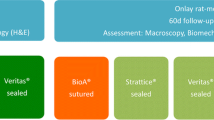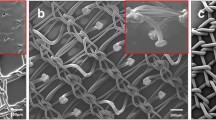Abstract
Background
Formation of recurrent inguinal and incisional hernia shows an underlying defect in the wound-healing process with an insufficient quality of scar formation. Even after mesh repair an altered collagen formation and insufficient mesh integration has been found as main reason for recurrences. Therefore, the development of bioactive mesh materials to achieve a local modification of the scar formation to improve patients outcome is advisable.
Materials and methods
A polyvinylidenfluoride mesh material (PVDF) was constructed and surface modified by plasma-induced graft polymerization of acrylic acid (PVDF + PAAc). Surface supplementation was sought by binding of gentamicin to the provided active sites of the grafted mesh surfaces (PVDF+PAAc+Gentamicin). In vivo modulation of collagen formation was evaluated in a standardized animal model where an abdominal wall replacement was performed in 45 Sprague–Dawley rats. Seven, 21, and 90 days after mesh implantation, collagen/protein ratio and the collagen type I/III ratio as well as the expression of type I alpha 1 collagen mRNA (SYBR Green real-time RT-PCR) were analyzed at the perifilamentary region. Additionally, expression of matrix metalloproteinases (MMP-8/-13) has been investigated immunohistochemically.
Results
Implantation of the PVDF + PAAc + Gentamicin mesh induced a significantly decreased expression of MMP-8 and MMP-13 at the interface 21 and 90 days after implantation compared to the other groups. Whereas no significant effect was observed comparing the overall collagen/protein ratio, the quality of collagen formation expressed by the collagen type I/III ratio showed significantly higher ratios around the PVDF + PAAc + Gentamicin mesh 21 and 90 days after implantation. Correspondingly, an up to 5.3-fold expression of type I alpha 1 collagen mRNA was found.
Conclusion
The present data confirm that a surface modification of PVDF mesh samples using plasma-induced graft polymerization of acrylic acid and supplementation of gentamicin is able to improve scar quality and mesh integration.




Similar content being viewed by others
References
Flum DR, Horvath K, Koepsell T (2003) Have outcomes of incisional hernia repair improved with time? A population-based analysis. Ann Surg 237(1):129–135
Jansen PL, Mertens PP, Klinge U, Schumpelick V (2004) The biology of hernia formation. Surgery 136(1):1–4
Basson MD (2003) Invited research review: Cell–matrix interactions in the gut epithelium. Surgery 133(3):263–267
Bellon JM, Bajo A, Ga-Honduvilla N, Gimeno MJ, Pascual G, Guerrero A et al (2001) Fibroblasts from the transversalis fascia of young patients with direct inguinal hernias show constitutive MMP-2 overexpression. Ann Surg 233(2):287–291
Zheng H, Si Z, Kasperk R, Bhardwaj R, Schumpelick V, Klinge U et al (2002) Recurrent inguinal hernia: disease of the collagen matrix? World J Surg 26:401–408
Rosch R, Klinge U, Si Z, Junge K, Klosterhalfen B, Schumpelick V (2002) A role for the collagen I/III and MMP−1/−13 genes in primary inguinal hernia? BMC Med Genet 3(1):2
Rosch R, Junge K, Lynen P, Mertens PR, Klinge U, Schumpelick V (2003) Hernia—a collagen disease? Eur Surg 35:11–15
Junge K, Klinge U, Klosterhalfen B, Rosch R, Stumpf M, Schumpelick V (2002) Review of wound healing with reference to an unrepairable abdominal hernia. Eur J Surg 168(2):67–73
Junge K, Klinge U, Rosch R, Mertens PR, Kirch J, Klosterhalfen B et al (2004) Decreased collagen type I/III ratio in patients with recurring hernia after implantation of alloplastic prostheses. Langenbecks Arch Surg 389(1):17–22
Junge K, Rosch R, Klinge U, Krones C, Klosterhalfen B, Mertens PR et al (2005) Gentamicin supplementation of polyvinylidenfluoride mesh materials for infection prophylaxis. Biomaterials 26(7):787–793
Gupta B, Plummer C, Bisson I, Frey P, Hilborn J (2002) Plasma-induced graft polymerization of acrylic acid onto poly(ethylene terephthalate) films: characterization and human smooth muscle cell growth on grafted films. Biomaterials 23(3):863–871
Lopez-De Leon A, Rojkind M (1985) A simple micromethod for collagen and total protein determination in formalin-fixed paraffin-embedded sections. J Histochem Cytochem 33(8):737–743
Junqueira LC, Cossermelli W, Brentani R (1978) Differential staining of collagens type I, II and III by Sirius Red and polarization microscopy. Arch Histol Jpn 41(3):267–274
Junge K, Klinge U, Klosterhalfen B, Mertens PR, Rosch R, Schachtrupp A et al (2002) Influence of mesh materials on collagen deposition in a rat model. J Invest Surg 15(6):319–328
O’Meara SM, Cullum NA, Majid M, Sheldon TA (2001) Systematic review of antimicrobial agents used for chronic wounds. Br J Surg 88(1):4–21
Guo Y, Xie C, Rodriguez RM, Light RW (2005) Factors related to recurrence of spontaneous pneumothorax. Respirology 10(3):378–384
Gilbert AI, Felton LL (1993) Infection in inguinal hernia repair considering biomaterials and antibiotics. Surg Gynecol Obstet 177(2):126–130
Hanssen AD, Spangehl MJ (2004) Practical applications of antibiotic-loaded bone cement for treatment of infected joint replacements. Clin Orthop Relat Res (427):79–85
Tweed C (2005) Prevention of surgical wound infection: prophylactic antibiotics in colorectal surgery. J Wound Care 14(5):202–205
Deysine M (2004) Infections associated with surgical implants. N Engl J Med 351(2):193–195
Tekos A, Prodromaki E, Papadimou E, Pavlidou D, Tsambaos D, Drainas D (2003) Aminoglycosides suppress tRNA processing in human epidermal keratinocytes in vitro. Skin Pharmacol Appl Skin Physiol 16(4):252–258
Sacha PT, Zaremba ML, Jakoniuk P (1999) The influence of antibiotics on phagocytic and bacteriocidal activity of rabbit peritoneal macrophages stimulated by filtrates of cultured t-lymphocytes. Med Dosw Mikrobiol 51(3–4):399–412
Keeling KM, Bedwell DM (2002) Clinically relevant aminoglycosides can suppress disease-associated premature stop mutations in the IDUA and P53 cDNAs in a mammalian translation system. J Mol Med 80(6):367–376
Wilschanski M, Yahav Y, Yaacov Y, Blau H, Bentur L, Rivlin J et al (2003) Gentamicin-induced correction of CFTR function in patients with cystic fibrosis and CFTR stop mutations. N Engl J Med 349(15):1433–1441
Clancy JP, Bebok Z, Ruiz F, King C, Jones J, Walker L et al (2001) Evidence that systemic gentamicin suppresses premature stop mutations in patients with cystic fibrosis. Am J Respir Crit Care Med 163(7):1683–1692
Geleilete TJ, Melo GC, Costa RS, Volpini RA, Soares TJ, Coimbra TM (2002) Role of myofibroblasts, macrophages, transforming growth factor-beta endothelin, angiotensin-II, and fibronectin in the progression of tubulointerstitial nephritis induced by gentamicin. J Nephrol 15(6):633–642
Wrzesniok D, Buszman E, Karna E, Nawrat P, Palka J (2002) Melanin potentiates gentamicin-induced inhibition of collagen biosynthesis in human skin fibroblasts. Eur J Pharmacol 446(1–3):7–13
Asch HL, Farnham PJ (1978) Effects of gentamicin on trypsin, chymotrypsin, and collagenase. J Infect Dis 138(2):257–259
Robson MC, Dubay DA, Wang X, Franz MG (2004) Effect of cytokine growth factors on the prevention of acute wound failure. Wound Repair Regen 12(1):38–43
Dubay DA, Wang X, Kuhn MA, Robson MC, Franz MG (2004) The prevention of incisional hernia formation using a delayed-release polymer of basic fibroblast growth factor. Ann Surg 240(1):179–186
Korenkov M, Yuecel N, Koebke J, Schierholz J, Morsczeck C, Tasci I et al (2005) Local administration of TGF-beta1 to reinforce the anterior abdominal wall in a rat model of incisional hernia. Hernia 9(3):252–258
Acknowledgements
This work was supported by the German Federal Ministry of Education and Research (BMBF grant project no. 03N4024) and by the Deutsche Forschungsgemeinschaft (DFG Kl 1320/2-1).
Author information
Authors and Affiliations
Corresponding author
Rights and permissions
About this article
Cite this article
Junge, K., Klinge, U., Rosch, R. et al. Improved collagen type I/III ratio at the interface of gentamicin-supplemented polyvinylidenfluoride mesh materials. Langenbecks Arch Surg 392, 465–471 (2007). https://doi.org/10.1007/s00423-006-0138-1
Received:
Accepted:
Published:
Issue Date:
DOI: https://doi.org/10.1007/s00423-006-0138-1




